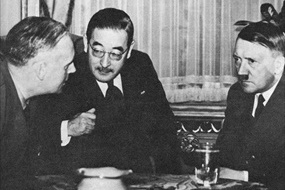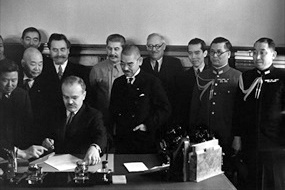JAPAN PUSHES SOVIETS FOR NEUTRALITY PACT
Moscow, Soviet Union (USSR) • March 23, 1941
On this date in 1941 Japanese Foreign Minister Yōsuke Matsuoka (1940–1941) arrived in Moscow after a 7‑day journey by train from the Siberian port city of Vladivostok. On this his first of 2 visits to senior Soviet officials, Matsuoka met Soviet Premier Vyacheslav Molotov. At the top of Matsuoka’s diplomatic agenda to 3 world capitals—the Soviet Union’s, Germany’s, and Italy’s—was his effort to reverse the previous December’s deadlock between his nation and the Soviet Union over the contents of a neutrality (or nonaggression) pact acceptable to both signatories, “pending,” as the U.S. ambassador in Moscow explained in a confidential February 27 telegram to the State Department, “the solution of certain outstanding questions between the 2 countries.” Indeed, last year’s draft had largely been held up by Japan’s refusal to cede the southern half of Sakhalin Island (Karafuto in Japanese) and certain islands in the neighboring Karil (Chisima) archipelago. The island territories had been awarded by the Treaty of Portsmouth to the Japanese following their astonishing victory in the 1904–1905 Russo-Japanese War. (For 30 years prior to 1905, south Sakhalin Island, which lay north of the large Japanese island of Hokkaido, had been valuable to Czarist Russia on account of its timber, coal, oil, and fish resources.)
According to Japan’s ambassador to Moscow (1940–1942), Lt. Gen. Yoshitsugu Tatekawa, Matsuoka’s visits to Berlin and Rome following his brief appearance in Moscow were strictly “camouflage”: the Japanese foreign minister really had “nothing he wanted to discuss” with Adolf Hitler or Benito Mussolini. The raison d’étre for his European trip was fulfilled during Matsuoka’s April return trip to Moscow, namely, finessing language what would become the Japanese-Soviet Neutrality Pact.
Signed in Moscow on April 13, 1941, by Molotov for the Soviet Union and by Matsuoka and Ambassador Tatekawa for Japan, the first article in the treaty focused on “maintain[ing] peaceful and friendly relations” between the 2 states and “respect[ing] the territorial integrity and inviolability” of each. Article 2 addressed the issue of neutrality should either nation “become the object of hostilities” by one or more non-contracting powers “throughout the duration of the conflict.” Article 3 defined the duration of the pact—5 years following its ratification by each contracting nation unless either nation “denounces the Pact one year before the expiration of the term”; otherwise, the pact would be automatically extended for another 5 years. On the same day the 3 statesmen signed a second treaty “pledg[ing] to respect the territorial integrity and inviolability” of their 2 client states on the Chinese mainland—Japan’s Manchukuo (Manchuria and Jehol), former provinces of Northeast China seized in 1931–1932, and the Soviet Union’s Mongolian People’s Republic (Outer Mongolia) since 1921.
Fortune did not reward the 2 contracting nations for long. Japan’s Tripartite Treaty (1940–1945) partner, Germany, mounted an unprovoked attack on the Soviet Union on June 21, 1941, 70 days after the signing of the Soviet-Japanese Neutrality Pact. On December 7, 1941, Japan mounted its own unprovoked attack against the United States 5½ months after that. In between June and December the United States in late October dispatched its first Lend-Lease aid to the Soviet Union, thus entering into an U.S.-Soviet military alliance that lasted through August 1945, when Japan capitulated to the Allies 14 weeks after Germany.
On April 5, 1945, Molotov, sole Soviet signatory to the 1941 Japanese-Soviet Neutrality Pact, stated that “Japan, ally of Germany, is aiding the latter in its war against the USSR [and] the USA and England, which are allies of the Soviet Union. . . . In these circumstances the neutrality pact between Japan and the USSR has lost its sense, and the prolongation of that pact has become impossible.” Three days later Molotov announced over Moscow radio that the Soviet Union stood with its Western allies and that “from August 9 the Soviet Government will consider itself to be at war with Japan.”
Foreign Minister Yōsuke Matsuoka Returns to Tokyo Bearing Gifts
 |  |
Left: German Foreign Minister Joachim von Ribbentrop, Matsuoka, and Hitler confer in Berlin as seen in this photo from late March 1941. On the eve of his much-publicized trip to the major capitals of continental Europe Matsuoka told reporters that following “a whirlwind of official duties [in Japan] . . . I have some leisure and I am taking this trip to Europe.” To counter any suspicions otherwise, the official Japanese news agency, Domei, assured the international community that “his [Matsuoka’s] mission to Europe is as peaceful as peaceful can be.” Hardly that. His treaty achievements in Moscow notwithstanding, his 2 visits to Berlin sandwiched between a visit to Benito Mussolini’s Rome were sweet music to the ears of Tokyo’s warlords. Should Japan “get into” conflict with the United States, “Germany would,” Hitler promised Matsuoka, “intervene immediately . . . , for the strength of the three Pact powers was their common action” lest they be picked off singly by the U.S. Hitler’s gratuitous and unsolicited 1941 offer became a verbal coda to Article 3 of the 1940 Tripartite (Axis) Pact entered into by Germany, Italy, and Japan the previous year in Berlin. In the aftermath of December 7’s surprise (to Hitler and Mussolini alike) Japanese attack on Pearl Harbor, Germany and Italy were perforce sucked into a world war with the United States, ready or not.
![]()
Right: The assurances Hitler and Ribbentrop gave Matsuoka in late March and early April 1941 were made all the sweeter for Japan’s war hawks following the successful negotiations Matsuoka and Tatekawa concluded with Soviet officials on the last leg of the foreign minister’s return to Tokyo. The Japanese-Soviet Neutrality Pact of April 13, 1941 (also known as the Soviet-Japanese Nonaggression Pact), ensured that Japan would not be dragged into a conflict between Germany and the Soviet Union when Nazi Germany unleashed its ill-fated attack on the Soviet Union in mid‑1941. Hitler’s skulduggery was, of course, in violation of the Soviet-German (Molotov-Ribbentrop) Nonaggression Pact that the 2 erstwhile enemies had signed in August 1939. Japan’s northern flank in East Asia was thus protected by mutual agreement when Japan expanded militarily into Southeast Asia; in turn, the Soviet Union’s eastern flank was protected by treaty with Japan as Stalin withdrew troops and materiel from Siberia to concentrate resources in the European theater of war. Matsuoka’s tease to reporters covering his departure to Europe in March 1941, namely, “I must return as soon as possible, as the Japanese nation seems to be looking forward to what presents I will bring back,” did indeed cheer—to say nothing about emboldening—Tokyo’s war planners. As early as January 1941 Adm. Isoroku Yamamoto had begun developing plans that culminated in the land-sea-air assault on American, British, and Dutch Asia-Pacific possessions in December of the same year. Interestingly, Matsuoka tried strangling the offspring of his April 1941 Moscow assignation within months of its birth, urging Japanese leaders to include invading Siberia in their war plans, but to no avail and he was dismissed from office.
The Role of the Japanese-Soviet Neutrality Pact in World War II
![]()

 History buffs, there is good news! The Daily Chronicles of World War II is now available as an ebook for $4.99 on Amazon.com. Containing a year’s worth of dated entries from this website, the ebook brings the story of this tumultuous era to life in a compelling, authoritative, and succinct manner. Featuring inventive navigation aids, the ebook enables readers to instantly move forward or backward by month and date to different dated entries. Simple and elegant! Click
History buffs, there is good news! The Daily Chronicles of World War II is now available as an ebook for $4.99 on Amazon.com. Containing a year’s worth of dated entries from this website, the ebook brings the story of this tumultuous era to life in a compelling, authoritative, and succinct manner. Featuring inventive navigation aids, the ebook enables readers to instantly move forward or backward by month and date to different dated entries. Simple and elegant! Click 











